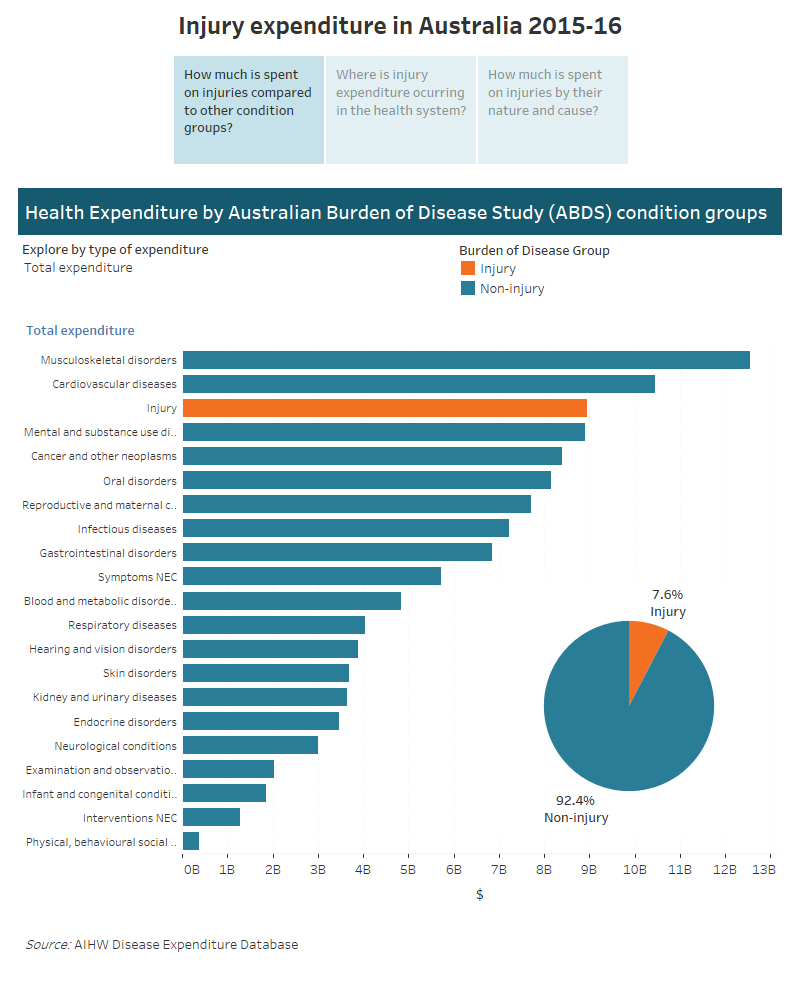Injury spending by health system area
About 78 per cent ($6.9 billion) of total injury-related spending was for hospital-based services in 2015–16. The other three major areas of spending, non-hospital medical services (13%), dental services (6%) and prescription pharmaceuticals (4%), contributed less than a quarter of total injury spending. Pharmaceuticals in this report does not include over-the-counter medication such as painkillers or anti-inflammatory medicines.
Hospital services
In 2015–16, 80 per cent of hospital-based injury spending ($5.6 billion) was for public hospitals and about 20 per cent ($1.4 billion) was for private hospital services. Of the $5.6 billion of injury related spending in public hospitals, 60 per cent ($3.3 billion) was for admitted patient care services and 27 per cent ($1.5 billion) was for emergency department services. Spending on outpatient services was $737 million (13.3%).
Of the estimated $374 per person spending on injury in 2015–16, about $290 was spent on hospital services. This was comprised of $138 for public hospital admitted patients, $64 on emergency departments, $58 for private admitted patients, and $31 for outpatient clinics.
By cause of injury, Falls were the highest area of spending in all hospital settings, 51 per cent of injury-related spending on private hospital services, 45 per cent on public hospital admitted care services, 31 per cent on public hospital emergency department services, and 38 per cent on public hospital outpatient services.
Non-hospital medical services
In this report, non-hospital medical services include those services provided by general practitioners, medical specialists, allied health practitioners (such as physiotherapists) and diagnostic services. Expenditure on medical services relates to services that were funded through the Medicare Benefits Schedule (MBS), and does not include privately funded health care.
In 2015–16, 13% of the $8.9 billion spent on injuries related to non-hospital medical services. About 42 per cent ($468 million) was on general practitioner services, 38 per cent ($421 million) on diagnostic imaging services, 11 per cent ($127 million) on medical specialist services, 6 per cent ($68 million) on allied health services, and 3 per cent ($34 million) on pathology services.
On a per person basis, about $47 of the $374 total per person injury-related spending was on non-hospital medical services. This was comprised of $20 for general practitioner services, $18 for diagnostic imaging services, $5 for medical specialist services, $3 on allied health services, and $1 on pathology services.
Considering cause of injury, injuries related to Falls were the highest area of spending in all non-hospital medical service settings. Fall-related injuries accounted for 33 per cent ($156 million) of the injury spending on general practitioner services, 37 per cent ($157 million) on diagnostic imaging services, 40 per cent ($51 million) on medical specialist services, 48 per cent ($32 million) on allied health services, and 37 per cent ($9 million) on pathology services.
Pharmaceuticals
In this report, pharmaceutical spending refers to spending on prescription medicines that occurs outside of the hospital setting. This does not include over-the-counter medications such as painkillers.
Injury-related spending on pharmaceuticals was estimated to be $325 million in 2015–16. Of the estimated $374 total per person injury-related spending, about 4 per cent ($14) was spent on pharmaceuticals.
Considering cause of injury, Falls were the highest area of spending on pharmaceuticals accounting for 34 per cent of spending.
Dental services
Injury-related spending on dental services was estimated to be $556 million in 2015–16. Of the estimated $374 total per person injury-related spending 6 per cent ($23) was on dental services.
Considering cause of injury, Falls were the highest area of spending on dental services. Falls accounted for more than a third of injury-related spending on dental services (37.3%).



